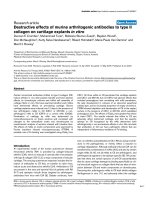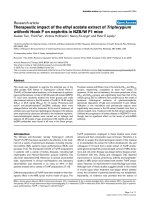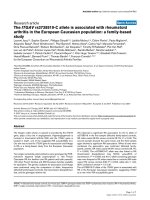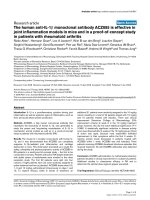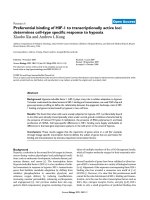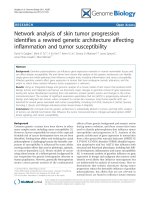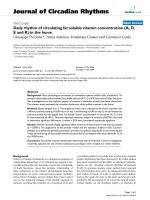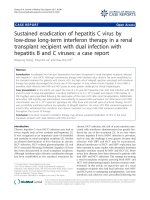Báo cáo y học: "The impact of the National HIV Health Care Worker Hotline on patient care in South Africa" docx
Bạn đang xem bản rút gọn của tài liệu. Xem và tải ngay bản đầy đủ của tài liệu tại đây (144.22 KB, 4 trang )
RESEARCH Open Access
The impact of the National HIV Health Care
Worker Hotline on patient care in South Africa
Briony S Chisholm
1*
, Karen Cohen
2
, Marc Blockman
2
, Hans-Friedemann Kinkel
3
, Tamara J Kredo
4
,
Annoesjka M Swart
1
Abstract
Background: South Africa has a huge burden of illness due to HIV infection. Many health care workers managing
HIV infected patients, particularly those in rural areas and primary care health facilities, have minimal access to
information resources and to advice and support from experienced clinicians. The Medicines Information Centre,
based in the Division of Clinical Pharmacology at the University of Cape Town, has been running the National HIV
Health Care Worker (HCW) Hotline since 2008, providing free information for HIV treatment-related queries via
telephone, fax and e-ma il.
Results: A questionnaire-based study showed that 224 (44%) of the 511 calls that were received by the hotline
during the 2-month study period were patient-specific. Ninety-f our completed questionnaires were included in the
analysis. Of these, 72 (77%) were from doctors, 13 (14%) from pharmacists and 9 (10%) from nurses. 96% of the
callers surveyed took an action based on the ad vice received from the National HIV HCW Hotline. The majority of
actions concerned the start, dose adaption, change, or discontinuation of medicines. Less frequent actions taken
were adherence and lifestyle counselling, further investigations, referring or admission of patients.
Conclusions: The information provided by the National HIV HCW Hotline on patient-specific requests has a direct
impact on the management of patients.
Background
Medicine information services aim to promote the safe
and effective use of medicine s [1]. The Medicines Infor-
mation Centre (MIC), which is based in the Division of
Clinical Pharmacology at the University of Cape Town,
has been in operation since 1980. Over the past 30 years
the MIC has received a constantly increasing number of
queries each year, with over 8 000 in 2008 and 2009.
With the public sector rollout of antiretroviral therapy
(ART), in response to the HIV epidemic in South Africa,
an increasing need for information on ART, especially
for health care workers in rural areas with little access
to expert advice, was identified. In 2008, an estimated
568 000 patients were enrolled for ART in South Africa -
449 000 in the public sector, 32 000 at Non-Governmental
Organisations and 86 000 in the private sector (Disease
Management and Workplace Treatment Programmes) [2].
The HIV and AIDS Strategic Plan for South Africa 2007-
2011 recognises that no single sector, ministry, department
or organisation can by itself be held responsible for the
control of HIV and AIDS [3] and an integrated approach
involving all sectors - public and private, health and non-
health, is being promoted.
In March 2008 the MIC, in collaboration with the
Foundation for Professional Development (FPD) and
PEPFAR/USAID, established the National HIV Health
Care Worker (HCW) Hotline. This toll-free hotline pro-
vides information to all health care workers in South
Africa on aspects concerning the treatment of HIV
infection and related diseases.
Queries are answered relating to a variety of topics
including HIV testing, post exposure prophylaxis, the
management of HIV in pregnancy, prevention of mother-
to-child transmission, when to initiate therapy, treatment
selection, recommendations for laboratory and clinical
monitoring, how to interpret and respond to laboratory
results, management of adverse events, drug interactions,
treatment and prophylaxis of opportunistic infections,
* Correspondence:
1
Medicines Information Centre, University of Cape Town, Cape Town, South
Africa
Full list of author information is available at the end of the article
Chisholm et al. AIDS Research and Therapy 2011, 8:4
/>© 2011 Chisholm et al; licensee BioMed Ce ntral Ltd. This is an Open Access article distributed under the terms of the Creative
Commons Attributio n Licen se (http://creativecomm ons.org/licenses/by/2.0), which permi ts unre stri cted use, distribution , and
reproduction in any medium, pro vided the original work is properly cited.
drug availability and adherence support. The hotline
operates from Mondays to Fridays 8.30 am - 4.30 pm.
The hotline number is 0800 212 506.
The queries are handled by four specially-trained drug
information pharmacists who share more than 50 years
of drug information experience between them. They
have direct access to the latest information da tabases
and reference sources, as well as to a network of experi-
enced clinicians and consultants across South Africa,
including specialists from the University of Cape Town’s
Fac ulty of Health Sciences, Groote Schuur Hospital and
Red Cross War Memorial Children’s Hospital. Queries
requiring clinical input are discussed with experienced
clinicians (just under 50% of queries received.)
Several previous studies have shown that both general
drug information centres and HIV hot/warmlines can be
a valuable source of information for health care workers
[4,5]. One study from a developing country (Uganda)
showed the s uccessful establishment of an HIV warm-
line to a very small, rural area [6]. A telemedicine
(e-mail) service for HIV/AIDS physicians, based in
Belgium and supporting developing countries, whilst being
perceived as valuable, has seen a decline in its use [7].
The objectives of this study were firstly to evaluate
whether enquirers use the information given to them by
the National HIV HCW Hotline. Secon dly, we aimed to
assess how the information provided impacted on
patient care. Thirdly, we aimed to describe which cate-
gories of health care worker were making use of the ser-
vice for patient-related queries. In addition, we wanted
to identify differences in the type of question asked, and
the action taken as a result of information given,
between health care worker categories.
Methods
The study was carried out between 3 August and 30 Sep-
tember 2009 at an independent drug information centre
situated i n the D ivision o f Clinical Pharmacology at the Uni-
versityofCapeTown,onroutinecallstotheHIVHotline.
The study received ethical approval from the Univer-
sity of Cape Town Faculty of Health Sciences Human
Research Ethics Committee.
To evaluate the impact of the information on patient
management, callers who asked patient-specific ques-
tions were contacted on the same day for a question-
naire-based interview on how they used the information.
For the duration of the study, the drug information
pharmacists in the MIC gave the name and contact
number of all HCWs who called the hotline with a
patient-specific query, to a specially trained administra-
tive assistant. The interview was conducted by her on the
day the query was asked. Health care workers who did
not have the time to answer the questions immediately
were given the option of receiving a faxed or e-mailed
questionnaire. Where h ealth care w orkers called m ore than
once in a day they were as ked to complete the question-
naire only for the first patient-related q uery of that day.
The basic information collected in the questionnaire
about the ca ller included the HCW category (doctors,
nurses, pharmacists, others), the province from where
they called and if they called from an urban or rural
area. The callers were then asked what actions were
taken out of a list of possible actions as a result of the
information received, whether they found that the infor-
mation provided was useful and whether they felt the
availability of the hotline benefited their patient.
The respondents’ willingness to complete the ques-
tionnaire was confirmed verbally and a positive response
taken as indicative of their consent. No consequences
accrued to respondents who decided not to participate.
Confidentiality of responses was maintained throughout.
Data captured on the questionnaire were entered into
an Excel
®
spreadsheet, and analyses were performed
using Excel
®
and STATA version 10 (Stata corp. College
Station, TX, USA).
Results
There has been a steady increase in the number of calls
to the hotline since its inception, with over 300 calls per
month in May 2010.
During the two months of the st udy, 511 calls were
received by the National HIV HCW Hotline, of which
224 (44%) were patient-specific queries. Table 1 shows
the distribution of the calls recei ved during the observa-
tion period among the different groups of HCWs.
The main group of HCWs using the hotline were doc-
tors with 3 55 (69%) calls. The number of calls/queries
received from pharmacist s, nurses and other HCWs was
72 (14%), 55 (11%) and 29 (6%) respectively.
Of the 511 total calls received over the period, the
proportion of patient-specific to non-specific calls was
highest amongst nurses, with 31/55 (56%) of the ir calls
being patient-specific, followed by doctors 167/355
(47%) and pharmacists 26/72 (36%).
We managed to contact 187 of the 224 (83%) callers
with patient-specific questions telephonically. Of these,
98/187 (52%) completed and returned questionnaires.
Four of the 98 questionnaires were not included in the
analysis. One questionnaire was completed in error, as
Table 1 Distribution of calls among the different HCW
groups
Doctors Nurses Pharmacists Other TOTAL
Patient specific
questions
167 31 26 0 224
Other queries 188 24 46 29 287
TOTAL 355 55 72 29 511
Chisholm et al. AIDS Research and Therapy 2011, 8:4
/>Page 2 of 4
the query was not patient-related. One questionnaire
was incorrectly filled in because the doctor misunder-
stood the instructions and ticked all the actions, having
used the service many times before, for several patients.
She however commented that the service was very use-
ful and ultimately benefitted her patients. The other two
questionnaires that were not included in the analysis
only contained information regarding the category of
HCW and the area they worked in, the rest of the ques-
tionnaire was not filled in.
Of the remaining 94 questionnaires, 72 (77%) were
received from doctors, 13 (14%) from pharmacists and
9 (9%) from nurses. There was no significant difference
in response rate between HCW catego ries (Chi-squared
p = 0.23.)
Fifty two (55%) of the 94 questionnaires were received
from HCWs practicing in urban areas and 37 (40%)
practicing in rural areas. In 5 (5%) questionnaires the
area of origin was unknown.
Ninety of the 94 participants (96%) stated that an
action was taken as a result of the information received.
Some participants reported more than one action taken.
Table 2 summarises the actions taken.
The most common actions taken concerned the start
(34%) and/or interruption or discontinuation (44%) of
ART. The most common reasons for medicines t o be
interrupted or discontinued were adverse events (33%),
treatment failure (11%) or drug interactions (5%). Dos-
ing adjustments were done in 19% of patients.
Actions taken with regard to the management of the
patients included further investigations such as l abora-
tory testing (35%), referrals to specialist facili ties (20%)
and admission to hospitals (10%).
There was no significant difference between health
care worker groups in terms of action taken.
Asked if the information provided by the National
HIV HCW Hotline was useful or not, 92/94 (98%)
found the information useful. One participant answered
no, stating the information given was not timely enough
and one did not fill in an answer. Fifty-seven partici-
pants (61%) found the information both useful for the
management of the specific patient but also for teaching,
research or personal knowledge. Twenty nine (31%) par-
ticipants found the information useful for the manage-
ment of the specific patient only and 5 (5%) participants
found it useful because of other reasons (teaching,
research, personal knowledge) only.
The last question on the questionnaire w as: “Do you
feel the availability of the hotline benefited your
patient?” All participants except two, who did not com-
plete this question, answered yes.
Discussion
The National HIV HCW Hotline was established in
March 2008, in response to the roll-out of ART in the
public sector of South Africa, to provide information
and decision support on the treatment of HIV infection
and related diseases. Use of the service has consistently
increased since its inception. We conducted the study
over the specific 2 month period as it was 5 years since
the rollout of ART. In addition, no major changes had
been made to the guidelines.
The most frequent users of the HIV HCW Hotline are
doctors, nurses and pharmacists, with docto rs being the
leading group, responsible for 355/511 queries (69%)
during the study period. This may reflect the fact that
medical doctors are still the predominant group
involved in decisions around HIV treatment in South
Africa.
About 44% of all callers over the study period had
patient-specific questions. This highlights that the HIV
HCW Hotline is frequently used as a resource to guide
direct patient management decisions. Nurses had the
highest proportion of patient-specific queries with 31/55
(56%), highlighting the important role the HI V HCW
Hotline is playing in assisting nurses with regard to
direct patient management.
Table 2 Action taken as a result of the information
received
Action taken /94 %
Medicine started 45 48
ARVs 32 34
Co-trimoxazole 0 0
TB treatment 5 5
Other 6 6
Medicine discontinued/interrupted 54 57
ARVs 41 44
Co-trimoxazole 5 5
TB treatment 4 4
Other 3 3
Reason for change
Adverse event 31 33
Failure 10 11
Interaction 5 5
Pregnancy 3 3
Other 3 3
Dose changed 18 19
Schedule changed 77
Changed ARV Regimen 32 34
Admitted patient to hospital 10 11
Laboratory testing/further investigations 33 35
Referred patient to specialist clinic/service 19 20
Lifestyle changes 17 18
Adherence counselling 36 38
Please note that some health care workers indicated that they had taken
more than one action
Chisholm et al. AIDS Research and Therapy 2011, 8:4
/>Page 3 of 4
Based on the resul ts of the survey, almost all (96%) of
the HCWs who called the National HIV HCW Hotline
with a clinical query during August and September 2009
reported that they made a change to their management
of their patient as a result of advice given.
Most of the action s that took place as a consequence
of the advice given by the hotline concerned direct
treatment related decisions such as initiation (34%),
dose adjustments (19%), discontinuation (44%) or
change of ART. However, a substantial proportion of
actions also concerned the overall management of
patients, such as the initiation of further diagnostic pro-
cedures, referrals to specialist services (20%) or hospital
admissions(10%).ThisdemonstratesthattheHIV
HCW Hotline is utilised not only for medicine specific
questions but for the overall management of the
patients.
Almost all callers interv iewed confirmed that the
information provided was useful and timely and to the
benefit of the patient.
It is a limitation of this study that the response rate of
thesurveywasonly52%.Wecannotexcludeabias
towards satisfied customers as unsatisfied customers
might have been less willing to respond.
Based on the findings of this study, we conclude that
the HIV HCW Hotline serves its purpose as a measure
to strengthen the public health system through informa-
tion, advice and decision support in t he management of
patients with HIV infection.
The current developments in the public health sector
are characterised by efforts to drastically increase the
number of HIV infected individuals on ART. Nurse
initiated management of ART (NIMART) is a goal of
the South African Department of H ealth [8], and nurses
will increasingly be drawn upon to initiate and manage
patients on ART.
Nurses form the bulk of HCWs at primary care level
in under-resourced settings in sub-Saharan Afric a [9].
They are frequently working in facilities where there is
limited contact with doctors or pharmacists, and may be
required to make prescribing and clinical management
decisions with little support. They will be required to
manage very ill patients, and will have to do so with far
less clinical train ing than doctors. A telephonic helpline
providing clinical advice and support may be a valuable
resource to support nurses in fulfilling this clinical
function.
Conclusions
The National HIV HCW Hotline provides useful and
timely information, advice and decision support that
directly impacts patient management. It is an essential
service to strengthen the public health system, especially
for HCWs who work in remote areas with poor access
to experts. The hotline will play an increasingly impor-
tant role in the ambitious expansion of ART services in
South Africa through NIMART.
Acknowledgements and funding
We would like to thank the health care workers who took the time to
participate in this study, as well as Samantha Carstens for her assistance.
The National HIV Health Care Worker Hotline is funded by the Foundation
for Professional Development via PEPFAR/USAID. The article processing fee
was paid for by the Foundation for Professional Development.
Author details
1
Medicines Information Centre, University of Cape Town, Cape Town, South
Africa.
2
Division of Clinical Pharmacology, University of Cape Town, Cape
Town, South Africa.
3
HIV & TB Medicine Unit, Foundation for Professional
Development, Pretoria, South Africa.
4
South African Cochrane Centre, MRC,
Cape Town, South Africa.
Authors’ contributions
AS conceptualised the study, participated in the design and coordination
and helped to draft the manuscript. BC participated in design and drafted
the manuscript. KC and MB made a contribution to conception and design.
KC performed statistical analysis. All authors revised the script critically and
read and approved the final manuscript.
Competing interests
The authors declare that they have no competing interests.
Received: 11 November 2010 Accepted: 26 January 2011
Published: 26 January 2011
References
1. Spinewine A, Dean B: Measuring the impact of medicines information
services on patient care: methodological considerations. Pharm World Sci
2002, 24(5):177-181.
2. Adam MA, Johnson LF: Estimation of adult antiretroviral treatment
coverage in South Africa. SAMJ 2009, 99(9):661-7.
3. HIV and AIDS and STI Strategic Plan for South Africa, 2007-2011. [http://
www.doh.gov.za/docs/hivaids-progressrep.html], (accessed December 2010).
4. Bertsche T, Hammerlein A, Schulz M: German national drug information
service: user satisfaction and potential positive patient outcomes. Pharm
World Sci 2007, 29:167-172.
5. Goldschmidt RH, Graves DW: The National HIV Telephone Consultation
Service (Warmline): A Clinical Resource for Physicians Caring for African-
Americans. J Nat Med Assoc 2003, 95(2 Supp):8S-11S.
6. Chang LW, Kagaayi J, Nakigozi G, Galiwango R, Mulamba J, Ludigo J,
Ruwangula A, Gray RH, Quinn TC, Bollinger RC, Reynolds SJ:
Telecommunications and Healthcare: An HIV/AIDS Warmline for
Communication and Consultation in Rakai, Uganda. J Int Assoc Physicians
AIDS Care (Chic) 2008, 7(3):130-2.
7. Zolfo M, Bateganya MH, Adetifa IM, Colebunders R, Lynen L: A
telemedicine service for HIV/AIDS physicians working in developing
countries. J Telemed Telecare 2010.
8. South African National Department of Health: Clinical Guidelines for the
Management of HIV and AIDS in Adults and Adolescents. 2010 [http://
www.doh.gov.za/docs/facts-f.html], (accessed August 2010).
9. Health Systems Trust, Indicators in Health Personnel: [ />healthstats/index.php?indtype_id=004002], (accessed August 2010).
doi:10.1186/1742-6405-8-4
Cite this article as: Chisholm et al.: The impact of the National HIV
Health Care Worker Hotline on patient care in South Africa. AIDS
Research and Therapy 2011 8:4.
Chisholm et al. AIDS Research and Therapy 2011, 8:4
/>Page 4 of 4
